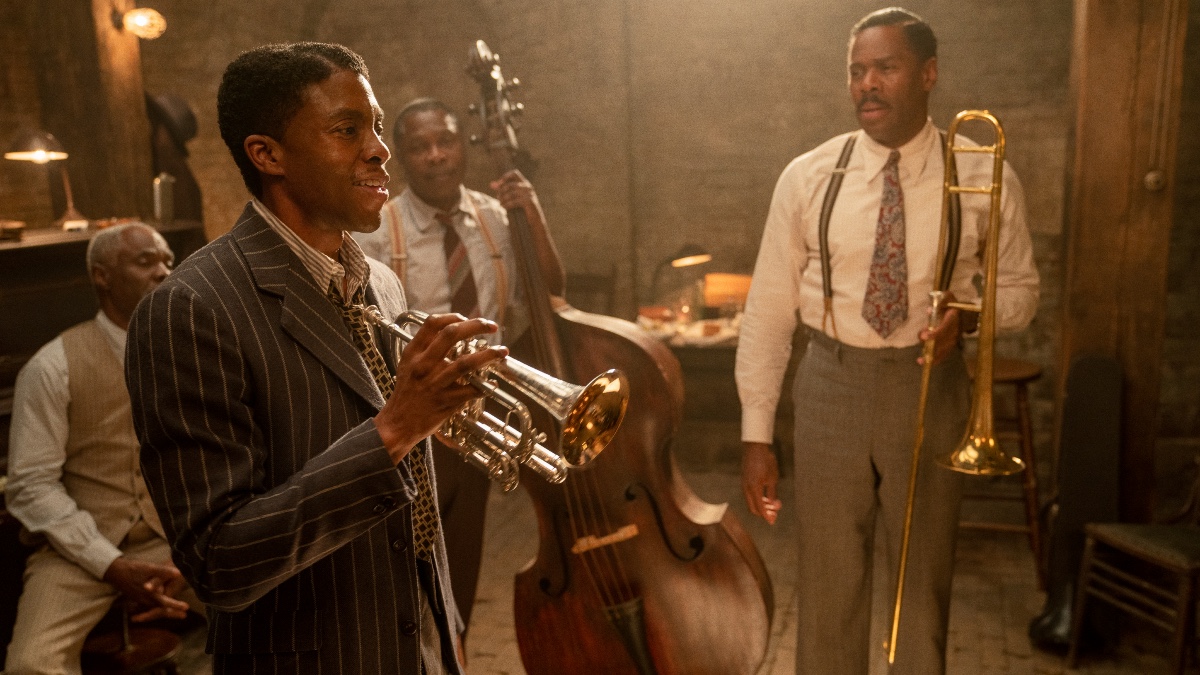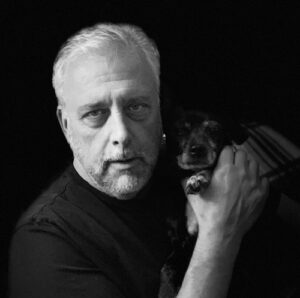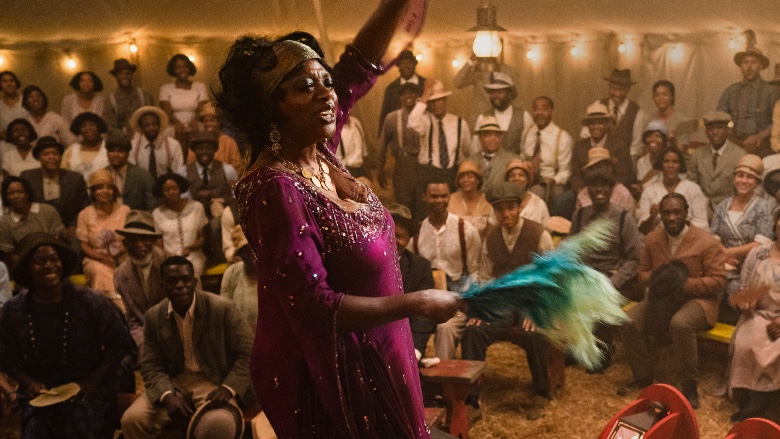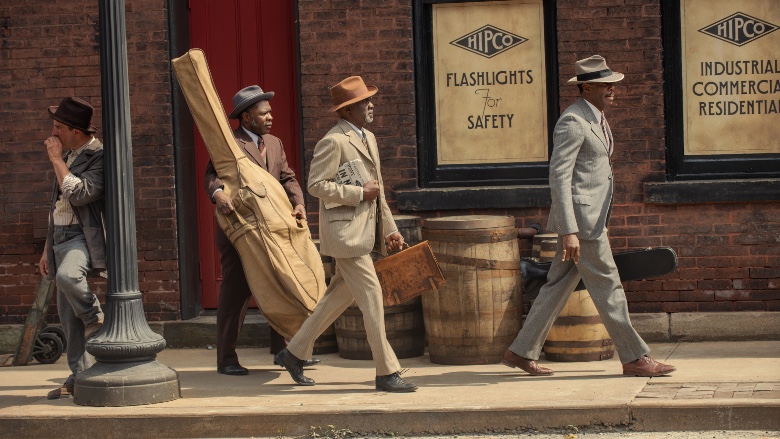
One of the best received films of 2020, Ma Rainey’s Black Bottom is a vivid adaptation of August Wilson’s landmark play. Directed by George C. Wolfe, the film explores a 1927 Chicago recording session featuring the celebrated blues singer Ma Rainey (played by Viola Davis) and her backup band, including trumpeter Levee Green (Chadwick Boseman, in his final performance).
The screenplay by Ruben Santiago-Hudson captures Wilson’s rhythmic dialogue as well as his insights into the racism that hobbled Rainey’s career. Music is a key element, from Rainey’s own songs to a soundtrack score by Branford Marsalis. Equally important to the movie are its sound environments, ranging from backwoods bayous to Chicago streetscapes. Re-recording Mixer Skip Lievsay, who partnered with Supervising Sound Editor Paul Urmson, spoke with Below the Line about working on the Netflix production.

Below the Line: When did you start working on the project?
Skip Lievsay: It had been completely shot, they were editing the picture. This was the first thing we did after the Covid-19 shutdown, it was just the two of us, Paul and me. We had some self-designed rules about who could be in the building, how we would work with George and Andy [Editor Andrew Mondshein].
The very first thing we did was develop a pretty elaborate temp mix for the first twenty minutes of footage. That way George could see what we were suggesting for the tone of the movie. That section included two live numbers, the first in a tent show, the next in a theater, then a montage of musicians getting to the recording studio.
BTL: What did he think of the temp mix?
Lievsay: You know, at a certain point, especially with the music in those two scenes, I felt we had gone too far in terms of volume. We pulled it back a bit, but George liked a big, bold beginning. He wanted a thundering city in contrast to the quite backwoods of the tent show, it was a way to emphasize Rainey’s journey from her home in Louisiana up north to Chicago. And he wanted Ma Rainey to be like a rock star.
BTL: Where did you find the sound for the montage of the musicians arriving at the studio?
Lievsay: Paul and I work as a team in general. I busy myself with dialogue, ADR and music. It’s up to Paul to find, record, procure, whatever, all the other sounds —the El, traffic, period cars, and everything else.
On my side, pretty much all of the music comes from either the Music Editor, Todd Kasow, or occasionally pieces added by Andy, like a source cue that might be playing in a room or a store.
The general path in the majority of movies is that the composer and music department create the music, it’s edited by the music department with the involvement of the picture editor, and then it gets passed to me for the mix.
BTL: Do you have a general approach to working on a project like this?
Lievsay: I break it up into “food” groups. Take dialogue: there’s exposition where the characters are introduced and their voices are established. We give the audience a hand by helping identify the characters by the sounds of their voices. Our job is to make a consistent sound so the audience can tune in and get a little closer to the characters.
For music and sound effects, you’re basically setting the scene, you’re establishing the audio in the world we’re going to dwell in for the next two hours. You are pitching a tent to make a presentation.
The bulk of the story gets told in a sort of middle period, where you’re exploring things that help push the audience, help provide information, help define the scene more fully. Flesh out the world we’re in.
Along the way you get to kind of shade the story. The music, of course, is creating different themes for different people or scenarios in the story. There you can lead the audience, or you can deceive them, or drive a story point home harder if you want.
The same goes with sound effects. You’re creating lightness or darkness or weight or drama or horror. It becomes a navigating and informational tool to help the filmmakers explain to the audience what’s happening.
BTL: What are some of the specific ways you flesh out the audio world?
Lievsay: It’s a little bit like sleight of hand. We’ve established the recording studio in the middle of the big city, and how Ma Rainey is not comfortable in Chicago. She’s there to perform in a venue and then go home.
People who live in the city don’t really hear the ever-present cars and trucks, the subways, people going by. Those sounds have a much bigger impact on people who don’t live in a city. So once we’ve established those general sounds, we can push them up or pull them back based on what’s happening in the story.
If you pull back the sounds, it gives the narrator more space. It’s a way to pull the audience in closer. And if you raise the sounds, that makes the audience realize they’re watching a scenario rather than just listening to a story.
BTL: The story takes place right when the industry was switching from acoustic to electrical recording.
Lievsay: Part of point of this film was that Ma Rainey resisted the mechanism of recorded music. Records were just becoming available, but she is all about live performance. It’s sort of like how the Maasai warriors won’t allow you to take pictures of them because they believe that part of their soul leaves them.
I particularly like the way that music has come around. In my time, musicians were about making records, and then they toured to promote those records. That’s how it worked for rock’n’roll. But the record business collapsed under its own weight, so now musicians have returned to live performances as their main outlet, their main way to make a living.

BTL: How did you approach mixing the music in the movie?
Lievsay: There were three primary types of music: one was the score, two was Ma Rainey’s songs, and three was everything else. We got into a sort of convention where “reverb” connotes “memory,” which is a common treatment. In a way it’s the gold standard for letting the audience know, “This is a memory.”
When Ma sings “Those Dogs of Mine” to Dussie Mae [played by Taylour Paige], her voice is up close and clear, but the piano’s quite reverb-y, as if it’s happening in her head, or at least not in the same room. So it’s clear that there wasn’t anybody sitting in the room playing the piano while she’s singing her a cappella part.
Once we had established that, it became a slightly symbolic approach that the music that wasn’t Ma was kind of reverberant. I personally wanted it to sound like it was in a large room like a music hall or small auditorium. I got a sound going that made me feel like I was in a church.
BTL: There’s an actual Ma Rainey song playing over the closing credits.
Lievsay: Yes, that was a real recording. I did work on that a bit, I tried to descratch it to make it a little less harsh. 78s have a sound. I always think of Enrico Caruso records when I think of 78s, which reminds me why I don’t like opera.
BTL: There’s a point where a white jazz band interprets one of Green’s compositions. It’s not nearly as good as what Green was doing.
Lievsay: That was quite easy to do, honestly. I treated it like the other recordings, but I made it more basic and elemental. The room sounds that I had made for the band’s recordings, I got rid of those and made it a little flatter, more like a ham radio type of thing. I didn’t go into a whole filtering thing — we didn’t go that far. It’s still a live recording in a room, whether it’s going to be on a 78 or not.
Ma Rainey’s Black Bottom is now playing on Netflix.






